Vince Darcangelo's Blog, page 9
October 30, 2014
Pleasuring the Collective Unconscious: A review of Chuck Palahniuk’s Beautiful You
I’ll start with a confession: This review has come along sluggishly. Time I’ve set aside for writing has instead been frittered away on mindless online gaming. It’s an affliction we’ll call 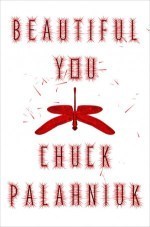 writus interruptus, and it’s likely to become an epidemic worse than any zombie apocalypse.
writus interruptus, and it’s likely to become an epidemic worse than any zombie apocalypse.
(Speaking of, my current addiction is The Last Stand: Dead Zone, and before I completed this sentence I had to stop to check on the construction status of a barricade.)
This isn’t anything new, really. In the 1950s, scientists discovered that if a rat could stimulate its brain’s pleasure center by pressing a bar, it would do so furiously until it passed out from exhaustion and, in many cases, died for lack of food and water. Mind you, the rats had access to food and water, but they couldn’t keep their paws off that pleasure bar.
This should sound familiar to any gamer who has missed a meal in order to level up.
It’s sick and wrong. I know this, but I need someone to hold up a mirror to face this absurdity directly.
This is why I love Chuck Palahniuk, whose new book, Beautiful You, is his best in a few years.
Fittingly, it concerns arousal addiction, and serves an electric shock to our collective conscience (or perhaps unconscious would be the better term).
Palahniuk took on male malaise with Fight Club, and mocked cultural over-consumption with Choke. Snuff (ostensibly a novel about pornography) lampooned self-destructive excess and exploitation in a manner that could very well have served as a hyper-sexualized predictor of the impending financial crisis of 2008.
In Beautiful You, he wanted to write what he calls gonzo erotica, and in the process has penned an anthem for an overstimulated, multi-tasking, computer-coma society.
Penny Harrigan is a nice Nebraskan girl working in New York City when she catches the eye of the world’s richest man, C. Linus Maxwell. Next thing you know, Penny is the talk of the tabloids and the envy of her coworkers.
Behind closed doors, however, is where Penny is truly transformed. Maxwell introduces her to a world of unimagined, if clinical pleasure. Penny has her reasons to question Maxwell’s motives (especially after a bizarre bathroom tryst with his bitter ex-lover), but is too enraptured with her newfound fame and sexuality.
Oozing with plot twists only Palahniuk’s sardonic tone could make palatable, Beautiful You aspires to remarkable levels of absurdity, but is it any more absurd than the daily inundation of product and marketing? Many reviewers have criticized the gratuitous satire in this novel, but is the idea of world domination via dildo really that farfetched in a culture that has financially sustained multiple cable shopping channels for three decades?
Beautiful You put me in mind of Rancid’s “Born Frustrated,” which asked, “Is this human freedom, hedonistic excess? Junky consumerism, mass production, toxic sickness?”
It’s why Romero’s Dawn of the Dead was set inside a shopping mall—can you truly be sure there aren’t a few zombies among you inside the IKEA? Ever been to a restaurant where a group of supposed acquaintances are each focused on their own smartphone or tablet?
We are a culture of instant gratification. We are a culture of distraction.
We are the lab rats hammering away at the pleasure bar for a taste of sweet, sweet oblivion.
And much like Maxwell, Palahniuk is there wearing a lab coat, taking copious notes and holding up a funhouse mirror to our cage, so that we might catch a distorted glimpse of what we’ve become.


October 16, 2014
Review: The Upside of Your Dark Side
The Upside of Your Dark Side
Todd Kashdan and Robert Biswas-Diener
So, I’m not exactly the target audience for this book, as I long ago embraced my 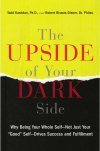 dark side, but I’m glad that Kashdan and Biswas-Diener, a pair of psychologists and professors at George Mason and Portland State Universities respectively, are promoting widespread awareness.
dark side, but I’m glad that Kashdan and Biswas-Diener, a pair of psychologists and professors at George Mason and Portland State Universities respectively, are promoting widespread awareness.
And no, this isn’t a Darth Vader-style enticement to evil, but rather a commitment to intellectual and emotional honesty. Embracing the dark side is being an anti-Pollyanna, acknowledging negative states of consciousness rather than suppressing them. Realizing that feeling bad is inevitable and natural.
Or, to let the scientists speak for themselves, “…we, the authors, reject the notion that positivity is the only place to search for answers. We reject the belief that being healthy is marked by a life with as little pain as possible.”
Perhaps it’s my love of Eastern philosophy, but I’ve always subscribed to an elastic emotional outlook: the greater the highs, the greater the lows. Inoculating oneself from pain only serves to numb one’s experience of joy.
It’s a conundrum that dates at least as far back as the dueling philosophies of the Cynics and the Stoics, but has become especially germane in the decades of post-WWII prosperity. At some point in the past 50 years, the fantasy that you could enjoy the thrills without enduring the chills became an accepted philosophy.
To seek comfort and happiness is natural, but now, the authors argue, it has become an addiction.
The self-help and pharmaceutical industries, along with positive psychology (to a lesser extent), have cultivated a bubble-wrapped culture where discomfort is treated as an abnormal condition. Not only is this unrealistic, it’s not healthy. There’s nothing wrong with feeling down sometimes, feeling angry sometimes.
“People who are whole, those of us who are willing and able to shift to the upside or the downside to get the best possible outcomes in a given situation, are the healthiest, most successful, best learners, and enjoy the deepest well-being.”
I’m reminded of my own experiences in therapy. I was the difficult patient who used my session time to challenge my therapist with my grim view of humanity. I would rattle off atrocities and injustice and point out that our culture rewards the worst kind of people and punishes the good. No, not just our culture—our species. Then I would grin triumphantly as the counselor struggled to argue against that.
I knew I’d finally found the right therapist when, during our first session, I gave her my misanthropy spiel. Her response: “Yeah, you’re right. So what?” Sometimes things are shitty.
This was the jolt I needed to crack my defiant shell and get to work on getting better.
Kashdan and Biswas-Diener hope to provide the same jolt to readers acclimated to a self-help mantra of “I’m OK, You’re OK,” and hopefully they are successful in this task.
They should be, as this is a very interesting read. What I like about The Upside of Your Dark Side is how the authors incorporate scientific research, positive psychology theory and personal anecdote to construct a cogent warts-and-all perspective of the human experience. Even though it features plenty of scientific research, the narrative is very accessible to lay-readers.
The shortcoming of the book, for me, is that the authors can be overly expository—they do a good job of illustrating a point, but then summarize said point as though they don’t trust the reader to draw the correct conclusion. But I wouldn’t mark down a letter grade for that. That’s the inherent risk with science writing. The authors have to take arcane material and present it to an audience that, for the most part, doesn’t share the authors’ background or familiarity with the topic.
Kashdan and Biswas-Diener by and large hit the sweet spot between academic and accessible. This is a book to be enjoyed by all—and to some a revelation.


October 11, 2014
Horror Shorts
Tomes of Terror
Mark Leslie
There are two things I like to do anytime I come to a new town:
Visit the local book shops
Take a ghost tour to learn about its haunted legends
So you can guess my excitement to read Mark Leslie’s Tomes of Terror, a collection of hauntings set in libraries and bookstores.
Leslie’s first two nonfiction books explored the haunted legends of Hamilton and Sudbury in Canada. This time he travels the globe recounting stories of specters who re-shelve library books, peruse the remainder pile or just want to sit in a quiet corner and enjoy a good book.
I can relate. My ideal afterlife would be spent on the top floor of the Boulder Book Store (with occasional sojourns along Pearl Street to Illegal Pete’s, of course).
As for Leslie’s collection, it’s a great read for any fan of ghost literature. It’s also a mixed bag, with some anecdotes chilling, some sweet, some silly.
There is one shortcoming in this book, but it is no fault of Leslie’s. It’s the medium. Sadly, the written word can’t compete with a spook story shared in hushed whispers around a campfire, so truly visceral frights are few.
Case in point: As much as I enjoyed both installments of Roz Brown and Ann Alexander Leggett’s Haunted Boulder series, their stories truly come to life when performed by master tour guide Banjo Billy. (I highly recommend both the books and the ghost tour, if you happen to be in Boulder, Colo.)
Despite the limitations of the printed page, I love any well-written and –researched book of hauntings. What I like most about them, I think, is that the tales turn out to be more historical than horrific. I’ve come to view ghost books (and tours) more as historical documents than anything else, but the kind that infuse a town with a lot of personality.
For me, it’s hard to truly love a place until I’ve explored its ghostly geography.
Fittingly, some of the most fascinating parts of Tomes of Terror are not the ghosts, but the histories of the libraries and stores themselves.
A sad postscript is that a fair number of the bookstores mentioned in this collection are now closed, becoming a different kind of ghost. And that’s truly terrifying.
But the stories never die, and in that sense, the shuttered stores live on in their own haunting way. Like ghosts, their spirits persist in the pages of Leslie’s collection.
Long may they haunt.
Mad Tales
Joseph Mazzenga
Come October, you can’t go wrong with a collection of horror stories on the nightstand (or anytime, really, if you ask  me). While not straight horror (Mazzenga incorporates elements of the weird, sci-fi and urban fantasy), Mad Tales is a collection of the creepy and creative befitting autumn, the best of all seasons.
me). While not straight horror (Mazzenga incorporates elements of the weird, sci-fi and urban fantasy), Mad Tales is a collection of the creepy and creative befitting autumn, the best of all seasons.
“Pepperell,” the lead story, truly stands out. It’s a fast-paced thriller fueled with a Twilight Zone aesthetic that disorients as well as it delights. The character development is a bit thin in this tale of outlaw bikers descending upon a quiet mountain town, but the “said the spider to the fly” motif compensates for the broadly sketched personalities.
There is no short-changing on the characters in “Bloody Depths,” a sprawling seascape of uncertainty that delivers its nightmares at an even pace. Here, we have more time to engage with the main character’s plight and share her dread as Mazzenga takes us to some weird—I mean really weird—places.
While they may incorporate elements of fantasy and sci-fi, each of the Mad Tales features a creepy tone that firmly establishes this enjoyable collection in the horror genre.


September 29, 2014
Review: Waking Up
Waking Up: A Guide to Spirituality without Religion
Sam Harris
My anticipation for the new Sam Harris book turned to anxiety when I learned it would be about spirituality. Was the firebrand philosopher and scientist—co-founder of Project Reason and author of The End of Faith and Letter to a Christian Nation—changing teams?
philosopher and scientist—co-founder of Project Reason and author of The End of Faith and Letter to a Christian Nation—changing teams?
Nah.
Perhaps a better title for this book, though, would be The Atheist’s Guide to Meditation.
At its core, Waking Up is about mindfulness, and as a fellow atheist who has attended a fair share of Buddhist retreats (including a recent one on Mindfulness-Based Stress Reduction), I can relate to some of the conflicts Harris encounters. No matter how secular the retreat, I get nervous when I find myself in a room full of people following the direction of a group leader offering spiritual betterment.
Harris takes out the touchy-feely and goes straight for the scientific foundation of a mindfulness-based approach to life. The result is a book heavy on Buddhist philosophy and refreshingly light on bullshit.
What makes Waking Up different is that it’s also what Harris calls a “seeker’s memoir.” We follow his journey from a skeptical teen to an adult struggling with the feelings of “unsatisfactoriness”—which is his interpretation of the concept of dukkha, rather than the traditional definition of suffering.
He had my attention early in the book, when describing the disquiet of his solitary thoughts and the relief he felt when experimenting with MDMA, LSD and DMT: “It would not be too strong to say that I felt sane for the first time in my life.”
Through his seeking, Harris reveals that, for him, spirituality is not the existence of a higher being in the ethereal realm, but rather the cognizance one has of an immaterial self. “Subjectively speaking, the only thing that actually exists is consciousness and its contents. And the only thing relevant to the question of personal identity is psychological continuity from one moment to the next.”
Speaking of continuity, Harris gets a little far afield the deeper we delve into the book. Beyond memoir, he explores the scientific underpinnings of consciousness and meditation, drops some knowledge about psychedelic drugs and, justifiably, rants on the silliness (and scientific dishonesty) of Proof of Heaven and other accounts of near-death experiences.
While I really enjoyed many of these sections, they didn’t have the cohesion of a linear narrative. It read more like a collection of essays on a single topic—which is fine, just not what I was expecting.
Harris’ informed and enlightened discussion of psychedelics resonates the most with me. Not only do I agree with his observations (and share some of his experiences), but Harris also challenges some of my long-held assumptions.
For instance, Aldous Huxley’s Doors of Perception is a seminal bit of psychedelic literature, and for years I bought in fully to Huxley’s description of the brain as a “reducing valve.” Harris debunks this by drawing on modern neuroscience, causing me to think about mind-manifesting drugs in a new way.
All told, Waking Up is an interesting and enjoyable read. There’s a bit of science writing, philosophy, memoir and a unique take on spirituality and meditation.


September 27, 2014
Review: Rock ‘n’ Roll Soccer
Rock ‘n’ Roll Soccer
The Short Life and Fast Times of the North American Soccer League
Ian Plenderleith
I recall, from my childhood, soccer on television, cheering for Pelé and watching him slow-motion bicycle kick his way through Nazis alongside Sylvester Stallone. And then it was gone.
I don’t remember when it went away, but in the early 1980s, my attention turned to music and girls. So long, Pelé. Farewell slow-motion bicycle kick. We hardly new ye. It didn’t even occur to me, until Major League Soccer started play, that there was no longer an elite professional American league.
Fast forward to 2014, and soccer in America is once again on the rise. It’s now expected that the U.S. men’s team will not only qualify, but advance to the knockout rounds of the World Cup. The bar is even higher for the medal-winning women’s club. MLS is approaching its 20th season, and the future is looking bright.
Couple that with the self-immolation of the NFL and in a few decades Monday Night Football might be a whole different ballgame. Literally.
The groundwork for today’s soccer popularity was laid by the North American Soccer League, the subject of Plenderleith’s Rock ‘n’ Roll Soccer. This is required reading in a World Cup year, and a treat to read anytime.
Plenderleith documents the folly, effrontery and ultimate failure of the NASL—an impressively thorough tome that benefits from solid research and a witty outsider’s perspective (though now living in America, Plenderleith is British and brings a European’s passion and insight to football writing).
One of Plenderleith’s great accomplishments in this book is his ability to zoom in and out of the action while keeping the reader engaged. This is not an easy task. At times, he’ll be recounting the exaggerated drug- and drink-fueled antics of over-the-hill international stars and young Americans performing in a flamboyant, fly-by-night federation that defied, in equal measure, rules, tradition and, ahem, sound business practice.
Then Plenderleith will step back and establish the international and cultural context within which the NASL was operating. At first, the international audience mocked the upstart Americans, and FIFA pushed back against the young league that was tinkering with tradition.
But as the NASL achieved early success, the world took notice. While it didn’t reinvent the sport, the outlaw league reinvigorated it by making it a fan-friendly experience and drove rule changes that increased substitutions and decreased back passes.
The model, though exciting, was as unsustainable as that alcohol-fueled borderline relationship you had in college. The peaks were unforgettable, but the valleys unbearable. Sure enough, the NASL folded following the 1984 season.
It was an experiment and experience that was thoroughly American, and though the league didn’t last, it left a lasting impression on the game and paved the way for MLS success.
Rock ‘n’ Roll Soccer is an excellent work of sports journalism and, regardless of whether you follow football or futbol (or both), it is worthy of any fans’ bookshelf.


September 26, 2014
Review: The Penguin Book of Witches
The Penguin Book of Witches
Katherine Howe, editor
It’s fitting that Penguin is releasing its annotated Book of Witches in time for Halloween—and not just because of the seasonal correlation of Wicca and the feast of Samhain. The history of the witch is long and complicated. The difficulty of distilling thousands of years of witchery into a single volume is perhaps best illustrated by considering the variety of Halloween 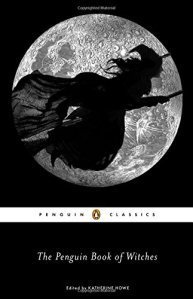 costumes celebrating the witch.
costumes celebrating the witch.
A cursory search of costume shops gives you such options as sexy witch, crone witch, neon witch or glitter/sparkle/glamor witch. Would you like a traditional black dress with a broom, or something made of lace? You could be a witch from Oz or Salem, Sabrina or American Horror Story.
And would you like a cat with that? Or perhaps a toad or flying monkey?
Oh, you can even dress up your dog as a witch, if you feel like it. Whatever. You go do you.
Point is, the witch is not a singular entity: it’s a character that has assumed many forms in film, folklore and the imagination, be it funny or frightening, sexy or silly, from the East Coast (good) or the West (wicked). In her introduction, author and academic Katherine Howe gives as good a definition as I’ve ever read:
“Witchcraft is less a set of defined practices than a representation of the oppositional, as the intentional thwarting of the machinery of power, whether that power lies with the church, with the king, or with the dominant cultural group” [xii].
Indeed, the bookshelf of my youth was loaded with books on the topic: fiction anthologies devoted to the witch; sensational Satanic Panic potboilers; historical and sociological treatises; feminist takes; and cumbersome source material such as the Malleus Malificarum and The History of Witchcraft and Demonology.
I wish this book would have been around back then. Howe does a great job of sampling the primary sources to create a palatable, yet thorough history. She begins with references to witchcraft in the Bible and guides us, inevitably, to Massachusetts Bay.
The meat of The Penguin Book of Witches are the trial transcripts and testimonies from that dark period of 1692-93. While the prose doesn’t exactly leap off the page here, the importance of these documents, and the clarity of Howe’s introductions, is worth enduring a bit of the old English.
That the Salem Witch Trials remain a relevant cultural reference more than 300 years later speaks to their importance. It remains one of our country’s greatest shames, and its memory serves as a reminder of how far we’ve come and a warning about how low we may sink.
Sadly, no matter how much humanity progresses, the same dark drive that fueled the colonial witch craze still smolders within us. The 20th century alone gave America two Red Scares, internment camps, the West Memphis Three, the Satanic Panic, the War on Drugs and all manner of smaller scale oppression, discrimination and fear-mongering.
The post-9/11 world has given us Guantanamo Bay, George Zimmerman and a Red State/Blue State schism.
Fittingly, Howe offers a word of caution as she segues into the closing section, “After Salem”: “While no witch trial in North America—or Europe, for that matter—would ever again approach the magnitude and fatality of the Salem episode, witch belief did not disappear. It merely changed form” [193].
This line, for me, is the ultimate takeaway from this book. Witches, as portrayed by Halloween costumes, are creatures of the imagination, folklore and literature. But by any name, the women who were burned, stoned and hanged were victims—not of demonic possession or supernatural forces, but of the all-too-human folly of superstition, prejudice and mob mentality.
The same goes for all victims of a witch craze. The importance of studying the witchhunts of the past is that they are difficult to recognize while they are happening. They occur under the insidious guise of patriotism, decency and traditional values. The label “witchhunt” is only applied in the aftermath.
By reading the transcripts of the trials and examinations, and the post-Salem mea culpas, we can hopefully prevent or at least minimize oppression in our time and in the ages to come.
Howe’s collection is a great place to start.


September 22, 2014
September Shorts: Nonfiction
September. The sunset comes earlier than the day before. That much-agonized-over summer reading list is about to expire, and how far did you get? How many books did you unofficially add?
Book lovers are an ambitious lot. If I never bought another book, I could probably read for a decade with the books I already have but haven’t read yet. Yet, you’ll still find me at the local bookstores, thrift shops and library fairs stocking up for the nuclear fallout that is the ultimate bibliophile fantasy (a la The Twilight Zone, sans the cruel ending, of course).
We’ll never get to all the books we want to read in a lifetime, let alone a summer, so here are some wonderful summer reads that you may have missed.
Our Great Big American God: A Short History of Our Ever-Growing Deity
Matthew Paul Turner
America has a complicated history with God. The Puritans, though devout religious misfits in England, laid the  foundation for the most successful secular democracy in the world. The paradox continues to play out through international politics. To Europe, we are considered zealots. To the Middle East, we are either godless heathens or Zionists.
foundation for the most successful secular democracy in the world. The paradox continues to play out through international politics. To Europe, we are considered zealots. To the Middle East, we are either godless heathens or Zionists.
Even within America, it’s complicated. Are we one nation or one nation “under God”? Depends on whom you ask and, perhaps more telling, in which state you pose the question.
Turner’s book begins with a similarly difficult question: “Where would God be without America?”
Well, he probably wouldn’t be as much fun, for starters. Beginning in the early 1800s, Turner writes, the modest ways of the Puritans gave way to rowdy revivals, complete with hops, flips, shakes and mysterious catatonic states followed by fits of frenetic celebration:
“Could the God who was causing people to get down on all fours or lie slain in the spirit really be the same God who led the Puritans across the Atlantic from England to Boston?”
Turner traces the legacy of America’s god, from the earliest settlers through Ronald Reagan and Sarah Palin, exploring the ways in which biblical interpretation got tangled up with political and economic unrest and swelling nationalism.
It’s a fascinating look at the past and future of the deity that America supersized and spread across the globe.
Factory Man: How One Furniture Maker Battled Offshoring, Stayed Local—and Helped Save an American Town
Beth Macy
A Taiwanese businessman once told John D. Basset III that when his country was on top “don’t expect us to be dumb  enough to do for you what you’ve been dumb enough to do for us.” Americans, he said, would do anything for a bargain.
enough to do for you what you’ve been dumb enough to do for us.” Americans, he said, would do anything for a bargain.
This fact fueled the offshoring of furniture making to Asia. The result was cheap foreign labor and cheaper products. In exchange, American factory towns were devastated as companies took their plants and their jobs overseas.
Basset, however, showed the eastern businessmen another side of Americans—they would do anything for what’s right, even at the cost of a bargain.
Basset waged a war against offshore vultures and even his own family. He was not necessarily a likable man, but his defense of his factory town is heroic and brilliantly recounted by journalist Beth Macy. One of the best reads of the summer.


September 21, 2014
All Due Respect Issue 4
Check out the new issue of the crime fiction magazine, All Due Respect, which features a nonfiction piece by yours tr uly. My article is a review of Joe R. Lansdale’s Cold in July, which was released earlier this year in conjunction with the film release. If you haven’t read the book or seen the movie, I highly recommend both.
uly. My article is a review of Joe R. Lansdale’s Cold in July, which was released earlier this year in conjunction with the film release. If you haven’t read the book or seen the movie, I highly recommend both.
The issue also includes a powerhouse lineup of crime fiction, including award-winning author Hilary Davidson. Last year, I reviewed her excellent novel, Evil in All Its Disguises, and fans of that novel (and new readers) will enjoy her short story, “A Hopeless Case.”


September 3, 2014
Review: We Should All Be Feminists
We Should All Be Feminists
Chimamanda Ngozi Adichie
This brief and brilliant essay (it comes in around 20 pages) from the celebrated author of Half of a Yellow Sun, Americanah 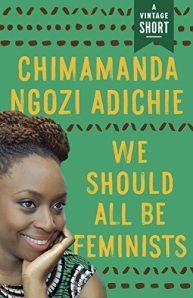 and Purple Hibiscus is one of the most interesting pieces I’ve read all year. It was adapted from Adichie’s famous TEDxEuston talk, and whether you prefer the visual or the text, make sure you get a hold of one of them.
and Purple Hibiscus is one of the most interesting pieces I’ve read all year. It was adapted from Adichie’s famous TEDxEuston talk, and whether you prefer the visual or the text, make sure you get a hold of one of them.
“Feminist” is a word long-since stripped of its original meaning: politicized, glorified, demonized. It’s got more ill-fitting baggage than an overhead compartment. Adichie cuts through the connotations to get at the core value of feminism and how it celebrates and benefits both men women.
Reading this essay brought me back to my first day of Human Sexuality class at Penn State. “How many of you consider yourselves feminists?” the teacher asked. None of us men raised our hands (I hadn’t yet learned that, by definition, men could be feminists), and maybe only half the women raised theirs.
The teacher asked the hands-downers why they weren’t feminists, and though the reasons they gave were myriad, every response was prefaced with some variation of “I support equality and fair treatment and don’t believe that women are inferior to men, but…”
Interesting.
The teacher’s point, of course, was to show the class how this word had been bastardized and appropriated by so many groups for so many reasons that half the women disowned the label. Adichie shares similar anecdotes of her own struggles with the term.
This was almost 20 years ago, and the word “feminist” is more loaded than ever. With one or more women expected to compete for the presidency in 2016, attack-ad narrators are surely practicing their intonations for the coming voice-over work.
The Nigerian-born Adichie addresses one of the most common criticisms of feminism: Why the gender-specific language? Why not humanist? Or equalist?
“Because that would be dishonest,” Adichie writes. “Feminism is, of course, part of human rights in general—but to choose to use the vague expression human rights is to deny the specific and particular problem of gender. It would be a way of pretending that it was not women who have, for centuries, been excluded. It would be a way of denying that the problem of gender targets women. That the problem was not about being human, but specifically about being a female human.”
But this isn’t an essay about terminology. It’s a call to arms to imagine a generation of children raised without the biases that, consciously and unconsciously, perpetuate gender norms. It’s a call to rethink masculinity so that the next crop of men grow up healthier than the last. It’s a call for all of us to “do better.”
The essay may be short, but the conversation it generates is long and important.


August 20, 2014
D&D 5.0
Dungeons & Dragons Player’s Handbook
I’ve long professed my love of D&D at Ensuing Chapters, and it’s been a hell of a summer for gamers. Wizards of the Coast, the game’s publisher, is releasing the 5th edition of the table-top role-playing game—and they’re spreading the love around.
The Basic Rules and Starter Set were released in July, and this week, Wizards published the Player’s Handbook. The fan favorite Monster Manual will hit shelves in September, and the essential Dungeon Master’s Guide will follow in November.
In honor of the new edition, here is a collection of our articles about D&D, from Ensuing Chapters and beyond. Enjoy.
D&D is a cultural phenomenon that has lasted decades, survived the sophistication of video games and artificial intelligence, rival RPGs and even the Satanic Panic. It’s gone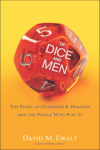 from nerd pastime to geek chic to sociological interest, and now its history has been documented in the wonderful Of Dice and Men: The Story of Dungeons & Dragons and the People Who Play It, a nostalgic romp through the author’s (and my) childhood.
from nerd pastime to geek chic to sociological interest, and now its history has been documented in the wonderful Of Dice and Men: The Story of Dungeons & Dragons and the People Who Play It, a nostalgic romp through the author’s (and my) childhood.
Ewalt, a senior editor at Forbes and self-described “writer, gamer, geek,” has done a great service to anyone who, with sweaty palms, has had to make a campaign-defining saving throw (or at least knows what that means). His smooth writing style and flair for narrative pacing makes the story of this greatest of games one of general interest, even if you’ve never tossed the 20-sided die. Read full article
Book Review: Playing at the World
Remember the first time you crawled a dungeon, slayed the dragon and stuffed as 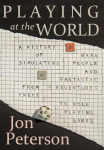 much treasure as you could into your “bag of holding”? Felt good, right? But the true prize wasn’t the booty. Sure, I enjoyed counting the gold and platinum coins, drooling over the prospects of upgraded armor, a magic-enhanced broad sword and whatever mischief I could scare up with a few copper pieces at the local tavern.
much treasure as you could into your “bag of holding”? Felt good, right? But the true prize wasn’t the booty. Sure, I enjoyed counting the gold and platinum coins, drooling over the prospects of upgraded armor, a magic-enhanced broad sword and whatever mischief I could scare up with a few copper pieces at the local tavern.
But what intrigued me most were the tattered spell scrolls, mysterious tomes and the secrets of the ancients.
It shouldn’t be much of a surprise. A rabid imagination is the primary tool that all fans of role-playing games bring to the table, and a trove of yellowed parchment and faded maps makes us froth at the mouth. Just how powerful is that fireball incantation? What wisdom could be discovered in that old paladin’s codex?
That’s what it feels like digging into Jon Peterson’s Playing at the World: A History of Simulating Wars, People and Fantastic Adventures, from Chess to Role-Playing Games. For any experienced gamer, this is a hoard worthy of any dungeon campaign. Read full article
Boulder Camera:
Game On: Dungeons & Dragons 4th Edition Releases on Worldwide D&D Game Day
Those outside the gaming world may have missed the news that Dungeons & Dragons—the legendary fantasy role-playing game in which players assume the roles of paladins and wizards and battle mythic creatures with a set of polyhedral dice—released the fourth edition of its series on June 6.
The new edition consists of three rulebooks—the Player’s Handbook, Dungeon Master’s Guide and Monster Manual—which can be purchased separately (entry-level players simply need the Player’s Handbook to get started) or packaged together as the Core Rulebook Collection. The rule changes in the new edition are designed to add more action to the game play and make it more accessible to entry-level players.
In honor of the release, Saturday was declared Worldwide D&D Game Day, and scores of locals celebrated at Boulder’s Karliquin’s Game Knight and Time Warp Comics. Both stores hosted in-store games to commemorate the release. Read full article
Boulder Weekly:
Keith Baker’s Boulder home is a fantasy geek’s paradise. An oversized bookshelf serves as an archive of role-playing game (RPG) modules, player’s handbooks and monster manuals. Posters of fantasy artwork grace the walls. Intricately designed miniatures of majestic dragons, mythical creatures and timeless warriors stand guard over counter space. Two broadswords hang over a mantle, and if you ask nicely Baker will give you a lesson in swordplay. After all, prior to becoming a novelist and game designer, he studied fencing and worked at Renaissance fairs.
If you knew Baker as a child, you probably wouldn’t be surprised.
“Instead of playing Cowboys and Indians, I ran around with friends playing Egyptian and Norse gods,” he says.
After showing an early interest in mythology, fantasy, the horror/sci-fi fiction of H.P. Lovecraft and the eerie artwork of Edward Gorey, it was no surprise that in 4th grade Baker became interested in a game called Dungeons & Dragons. Read full article





